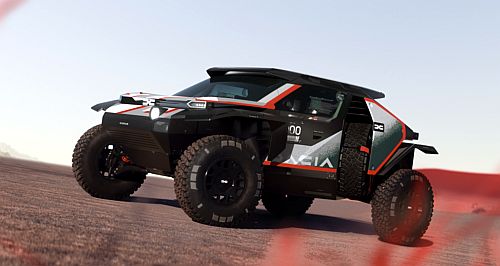Make / Model Search
Future models - Dacia - Sand RiderSandrider points to hardcore Duster variantRenault says hardcore concept a test bed for ruggedised Duster, and ute-based alternative8 Aug 2025 By MATT BROGAN RENAULT Australia has launched its all-new Duster to local media this week, the high-riding compact SUV a taste of what’s to come, according to the French importer, that says an even more capable example is under evaluation.
Speaking with media gathered for the launch of the ruggedised model, Renault and Dacia Duster global program director Julien Ferry said that while a more off-road focused variant is yet to be announced, it is one of a number of options possible from the Duster platform, that will also include a utility version for selected markets.
“There is discussion, clearly. We have had many discussions (around this topic),” he said.
“If we want to do a very aggressive version (of the Duster) it will go more toward the styling of the vehicle rather than its behaviour as a four-by-four, because we are very happy with where we stand.
“(That said), an electric four-by-four – where the rear axle is electric – will come in Europe, basically as an enhancement.”
Mr Ferry said that while it is not known if a petrol-electric model is under consideration for Australia, it is one that could help the importer meet tightening emissions regulations, while continuing to deliver the four-wheel drive abilities Duster customers will come to enjoy.
“While I don’t know whether this will come to Australia just yet, I understand you have a penalty in terms of CO2 emissions that the launch of this vehicle may assist, as it will bring down overall fuel consumption,” he added.
“That is the main goal (of adding an electric motor to the rear axle), not to change the four-by-four behaviour of the car.”
Mr Ferry explained that while the electric motor could be used to benefit initial acceleration and the throttle response of the petrol engine, it will also provide electric-only driving over shorter distances when operating in “full electric mode”.
“While today an electrified version is not in the Duster line-up, I think that if you look at what we are doing worldwide you can see that this platform is capable of going fully electric,” he explained.
“We are studying (electrification) because the market is there. For example, in Europe, there is huge pressure on CO2 emissions and fuel consumption, so we are looking at it (electrification) for the future.
“On this very same platform we are also building a car which is called the Niagara. It will be in the South American market, and we will see if it’s possible also for Australia.”
That vehicle will enter production in Argentina later this year as a successor to the Dacia-based Oroch – a four-door utility with up to 650kg payload capacity measuring just 4700mm in length.
Built for both domestic and export markets, the Renault Niagara shares much of its underpinnings with the third-generation Duster sold locally, supporting petrol and mild hybrid drivelines in two- and four-wheel drive configuration, the latter Mr Ferry describes as a “real asset” to the model’s capabilities.
“The four-wheel drive system, as well as the (light) weight of this car, is a real asset,” he told GoAuto.
“Obviously, both of these characteristics help with the Duster’s four-wheel drive performance, but it also helps to lower the fuel consumption of the car, improve the ride and handling, and the CO2 emissions.
“We have also improved the electronics system a lot when compared with the older generation (car). This gives the Duster another layer of control, and aids considerably in its propulsion. In fact, the torque application to the road in four-by-four situations is really quite amazing.”
Mr Ferry further hinted that technologies under study in the Dacia Sandrider rally car may be used in production vehicles down the track.
Inspired by the 2022 Manifesto concept car, the Dacia Sandrider is designed specifically for rally-raid events, drawing on the expertise of both the Renault Group and Prodrive, a UK-based company specialising in motorsports.
Like the Duster, the Sandrider focuses on weight reduction and agility, moves Dacia/Renault say are “strongly aligned” with their core values.
“Styled by Dacia’s in-house designers, the no-frills exterior of the Sandrider goes straight to the essentials,” Dacia said in a statement.
“The vehicle is fitted with body panels only considered as an absolutely necessity. There are no decorative or superfluous parts and naturally, particular emphasis has been placed on aerodynamics.
“The Dakar and other rally-raids are some of the world’s toughest motorsport events. For this reason, Sandrider required an approach that takes Dacia’s robust, outdoor concept to the extreme.
“This involved strengthening the vehicle, with a consolidated subframe and bumpers, carbon bodywork, double wishbone suspension and a 4x4 transmission built for the gruelling requirements of rally-raid events.
“An innovative electrical system maintains optimum power for all on-board accessories, even in the most difficult conditions,” it said, perhaps echoing the sentiments expressed by Mr Ferry.
“Engineers have worked particularly hard to make the car lighter and to reduce fuel consumption. The overall weight of Sandrider has been cut by around 15kg in relation to comparable prototypes.
“What’s more, particular emphasis was placed on aerodynamics to reduce fuel consumption while improving performance. Engineers were able to reduce drag by 10 per cent and lift by 40 per cent in relation to comparable prototypes.”
While it’s unlikely the 265kW/539Nm twin-turbocharged 3.0-litre V6 engine found in the Sandrider will make its way to the production line anytime soon, the lightweight construction and enhanced electrical architecture from this rolling test bed prove Renault/Dacia is working toward a ruggedised off-roader we hope to see in showrooms soon.
Watch this space.  Read more1st of July 2025  Duster sweeps in from under $32KRenault prices its Duster SUV for Australia, two-variant range generously specified17th of October 2024  Dacia goes bigger, maybe better, with BigsterThe Dacia Duster’s Bigster brother could be just what Renault needs in AustraliaAll future models Alfa Romeo Alfa Romeo Abarth Abarth Audi Audi Aston Martin Aston Martin BMW BMW Bentley Bentley Chrysler Chrysler Chevrolet Chevrolet Dodge Dodge Citroen Citroen Ferrari Ferrari DS DS Ford Ford Fiat Fiat FPV FPV Foton Foton Haval Haval Great Wall Great Wall Honda Honda Holden Holden Hyundai Hyundai HSV HSV Isuzu Isuzu Infiniti Infiniti Jaguar Jaguar Iveco Iveco Kia Kia Jeep Jeep Land Rover Land Rover Lamborghini Lamborghini Maserati Maserati Lexus Lexus McLaren McLaren Mazda Mazda Mercedes-Benz Mercedes-Benz Mitsubishi Mitsubishi Mini Mini Opel Opel Nissan Nissan Porsche Porsche Peugeot Peugeot Ram Ram Proton Proton Rolls-Royce Rolls-Royce Renault Renault Skoda Skoda Saab Saab SsangYong SsangYong Smart Smart Suzuki Suzuki Subaru Subaru Toyota Toyota Tesla Tesla Volvo VolvoMotor industry news |
Click to shareDacia modelsAll future models Alfa Romeo Alfa Romeo Abarth Abarth Audi Audi Aston Martin Aston Martin BMW BMW Bentley Bentley Chrysler Chrysler Chevrolet Chevrolet Dodge Dodge Citroen Citroen Ferrari Ferrari DS DS Ford Ford Fiat Fiat FPV FPV Foton Foton Haval Haval Great Wall Great Wall Honda Honda Holden Holden Hyundai Hyundai HSV HSV Isuzu Isuzu Infiniti Infiniti Jaguar Jaguar Iveco Iveco Kia Kia Jeep Jeep Land Rover Land Rover Lamborghini Lamborghini Maserati Maserati Lexus Lexus McLaren McLaren Mazda Mazda Mercedes-Benz Mercedes-Benz Mitsubishi Mitsubishi Mini Mini Opel Opel Nissan Nissan Porsche Porsche Peugeot Peugeot Ram Ram Proton Proton Rolls-Royce Rolls-Royce Renault Renault Skoda Skoda Saab Saab SsangYong SsangYong Smart Smart Suzuki Suzuki Subaru Subaru Toyota Toyota Tesla Tesla Volvo VolvoMotor industry news |











Facebook Twitter Instagram